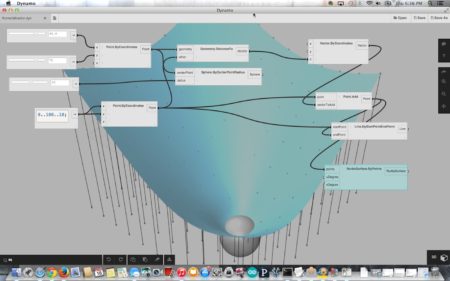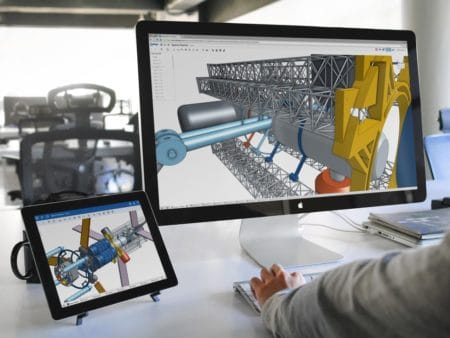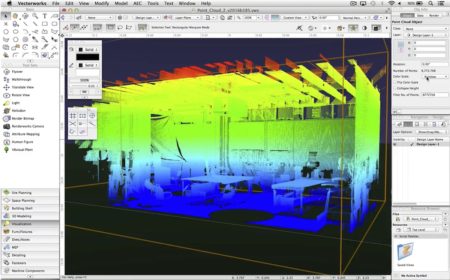2015 was a breakout year for CAD on Mac. Are you surprised?
To be entirely honest it’s the type of revelation that snuck up on me too. But here is why the year 2015 was the best year ever in the history of CAD on the OS X platform. It starts with explosive demand and growth on the platform. And the irony of all of this is that today Apple’s actual Mac computer lineup isn’t all that revolutionary or different than what one can find in the Windows world. But I’ll get to that in a minute.
In Summary
Take this next paragraph as the executive summary it is actually meant to be. In short, 2015 was the best year in CAD for Mac because several key new product developments came to the platform in concert with a global shift within the CAD industry in how CAD will be likely delivered in the future: namely the cloud. Combine this with Apple’s enterprise push and global growth of its ecosystem and things have never looked so good.
MORE: Apple’s Enterprise Strategy: Japan’s largest AEC companies going ‘all iPad’
But the story is also interesting because it is not about the hardware. Nor is it about performance. The underlying story helping drive this market change is really all about access.
Here are the five reasons—in detail—why 2015 was the best year in CAD for Mac.
Reason 1—Onshape Points the Way
Likely the biggest story of 2015 for the CAD world is the emergence of Cambridge, Massachusetts-based Onshape. Onshape is demonstrating in its success that a true, fully cloud-based CAD offering can work entirely through a standards based web browser. The net result is the operating systems don’t matter. At least on the desktop. And that’s huge for the CAD industry to say that.
And Onshape is a big Apple fan too. The company has told this author that the majority of its software coders are writing their code and working on the Mac. Onshape is driven by SolidWorks veterans combined with very talented Gen-Y (Millennials) coders and engineers. Think Facebook became a CAD company.
MORE: Visionary Silicon Valley firm joins Onshape Team
One of the most impressive things about Onshape is that their solution works on iPhone, iPads and Android devices. And here’s the biggest gold nugget of all: one out of six sessions (on Onshape) was done on a mobile device, and 50 percent of all its Onshape Professional users use mobile. That kind of data tells the market firmly that our iPhones can be—and want to be—enterprise computing devices. That’s news that will surely please Apple’s CEO Tim Cook.
What Onshape has done is actually liberate the CAD world from the world of Windows hegemony. This is the Berlin Wall moment in the history of CAD. But unlike President Reagan challenging Russia’s Mikhail Gorbachev to tear down the Berlin wall, Onshape has run its Onshape tank right through the Windows CAD hegemony wall.
Reason 2—And God said: “Let there be Rhino on Mac”
God may have made all of Creation in six days and rested on the 7th, but Robert McNeel & Associates seemed to be of no hurry in creating a native final version of Rhino on the Mac—until the year 2015!
Commencing approximately 8-9 years ago, Rhino for Mac has been in free beta until the first official release this past summer when in early September it went “commercial.” Time for everyone to pay up but paying up also meant things were now getting serious. Rhino isn’t just Rhino, it means Grasshopper as well and this is where the future is looking bright because the folks at McNeel have Grasshopper for OS X also underway.
Rhino + Grasshopper has become the avant-garde toolset for the world’s most ambitious and talented architects. This includes architecture students worldwide. From its use in award winning firms like BIG in Copenhagen to industry giants like Nikken Sekkei in Japan, Rhino + Grasshopper is truly of a watershed like importance in architecture and having Rhino for Mac gone officially commercial is a major key step forward to enabling Mac-based architects the world over to get more involved in Rhino and Grasshopper as well as provide access to another platform.
Reason 3—What a Sneak Peak at Dynamo Studio on Mac Tells Us About Autodesk
Back in June Autodesk gave Architosh an exclusive peak at Dynamo Studio running on Mac. Dynamo Studio running on Mac is not, in itself, reason number 3. Yet, there is something about this event and its existence that says much about CAD on the Mac.
Dynamo Studio running on Mac is a “technology preview”, something Autodesk has been doing over the past few years. What the Dynamo team has done is peel back the code base to its core libraries and then using newish code development technologies that are platform agnostic—like Javascript and HTML5—develop new front-end user-interfaces that enable access to the core code in different ways, whether via the browser or through mobile apps.

02 – A screenshot of Autodesk Dynamo running on Mac OS X. Proof positive that the CAD giant has the chops to move swiftly and creatively.
The reason why this is noteworthy to mention is because back in the 1990’s and early 2000’s CAD applications were developed as monolithic code bases comprising C and C++ code cores with Microsoft Windows UIs. Autodesk is learning how to “atomize” is code assets and execute programming optionality. This is important because other companies may likely follow in its footsteps.
Reason 4—The DWG Wars Have Reached Mac Shores
When Architosh launched in 1999, we were quickly contacted by Apple. One of our first contacts was Apple’s Creighton Nolte, an architect by training who was a marketing manager at Apple in what Apple typically called its “pro markets.” Creighton had immense passion and knew architects loved Macs. And Apple had just launched its AppleMaster series and architect Zaha M. Hadid was the first architect to join the new AppleMasters class, as they called it.
But Steve Jobs had no interest in the Architecture market. But why…?
Many moons later and after many discussions with many high-level folks (mostly outside of Apple) but close to it, I was told that Steve Jobs felt there was no point in pushing Macs in the Architecture market if AutoCAD for the Mac wasn’t on the platform. Recall that when Jobs came back to Apple one of the first things he did was stitch up Apple’s relationship with Microsoft and ensure Microsoft Office for Mac was ongoing.
Eventually AutoCAD for Mac did come back to the platform, in 2010.
Meanwhile, while some CAD journalists, pundits and users thought it was a waste of Autodesk’s energy to focus on the Mac (or Apple for that matter…can you believe that?) an ensuing DWG War was brewing, including law suits involving the use of the term DWG. But the real war was brewing with applications themselves and two branches of threat to Autodesk’s hegemony over the DWG lingua franca in the CAD world.
Those two branches have emerged as Bricsys and Graebert. In the fall of 2014 the former’s BricsCAD emerged natively for Mac but in 2015 the company opened up shop in the United States, the world’s largest CAD market. Meanwhile Germany’s Graebert had a sensational year in 2015 in code development and global partnerships, including being chosen as the drawing engine partner for none other than Onshape.
The DWG Wars have complicated implications. What’s important to remember about all of this is that the Mac OS X environment is front and center in all of it. Jobs was wrong to have no interest in the Architecture market because of the lack of AutoCAD. Architecture was moving to BIM anyway. But the legacy of 2D DWG-based CAD is an important issue and that file format will live with us all for another two decades.
Reason 5—Mac Stalwarts Lead in Innovation
Despite all the newcomers (Onshape) and the old guard moving away from Windows towards a pluralization in code development, the Mac stalwarts in CAD are still market leaders in innovation. And 2015 saw some sensational development milestones.
Mac CAD leader Vectorworks was first to market with a native OS X based, visual script-based algorithmic modeler in its new Marionette technology. Taking the exact opposite approach Autodesk is now taking with Dynamo Studio, Vectorworks is touting the coupling of its Grasshopper-like technology directly inside a BIM application. And Marionette is just scratching the surface of the massive update in Vectorworks 2016.
MORE: Scripting the Future—Vectorworks CEO Talks Marionette, Design Summit and Future Direction
Meanwhile, the birthplace of BIM still remains a rich source of innovation. Graphisoft, like Roman General Marcus Aurelius two thousand years before, remains richly inspired along the banks of the Danube River in Hungary. Not far from the literal center of ancient Roman city Aquincum, where parts of Aurelius’ famed Meditations was written, ArchiCAD is coded with great inspiration and ample meditation on what is truly needed and key for architects in a BIM tool.
Graphisoft has proudly boasted that their ArchiCAD is “software for architects created by architects.” And in many ways, and in its history, it shows.
That is perhaps why in 2015 Architosh wrote a major feature on the use and preference of ArchiCAD by superstar Danish architecture firm BIG (see, Architosh, “How BIG’s influence can reframe the role of BIM in Architecture,” 18 April 2015). At the present the Bjark Ingels Group is more influential than any other architecture architecture firm in the world.
If reasons 1-4 were true and yet the Mac stalwarts were falling behind the story of CAD on the Mac would be somewhat mixed and even perhaps dispiriting. But nothing could be further from the truth.
There are four major software houses (development superpowers) in the AEC world, and the Nemetschek Group is not only one of them but, despite being its smallest (and is it really when actual dollars are separated into pure AEC jars…?) in 2015 its publicly traded stock has out performed both Autodesk and Trimble Navigation securities.¹ On top of superb financials the Munich-based holding company that holds both Mac CAD stalwarts, also made two excellent major acquisitions in the past 14 months that will bolster the capacities of both Vectorworks and ArchiCAD.
In short, the Mac stalwarts in the CAD market have had a robust and sensational year in 2015, are generating much innovation, and within their “Group” have an enviable balance sheet and growth rate.
Conclusions—Getting Back to Access
2010 was a landmark year for the Mac CAD world when AutoCAD came back to the platform. Yet even then, folks immediately bemoaned the lack of Revit and MCAD products. It was one big step forward but many steps still remaining.
Advertisement
In 2015 the Mac CAD market had a transformative year. Beyond these five core reasons one can also make note of Autodesk Fusion 360, the growth of SketchUp as a platform, the wave of cloud-based delivery systems to bring Windows apps to any desktop—like Frame a company we have written much about—as well as promising virtualization technologies.
At this point in time there has never been such a robust and healthy CAD market for the Mac platform. Yet, the great irony is Apple’s most interesting Mac hardware days with respect to CAD are maybe behind us. What people care about more right now is access. Computing power is of less importance. The anywhere, any device mantra is the new normal.
Looking ahead to 2016, I expect more of the same on all these key developments. At some point Revit will be delivered to the architectural market in a new way that will make the machine you work on pretty meaningless. At the same time, cloud services will take over on the power bandwidth spectrum. Software development will target different functionality at different host locations. Parallelization will move increasingly to the cloud and tap the GPUs, which in turn will do far more than just visualization work.
Notes
1 – Nemetschek AG is traded on the European XETRA exchange. Its share price in January 2015 was hovering around 12.65 eur. and is now over 42.98 eur.





Reader Comments
RT @BIMSummit: 5 Reasons why 2015 was The Best Year for CAD on the Mac https://t.co/sDHkfhc5hs via @architosh
[…] was a particularly good year for CAD software on Mac with architect website Architosh declaring 2015 the best year ever for CAD on Mac. A lot of this was due to more developers recognizing the growing demand on OS X and putting CAD […]
Comments are closed.